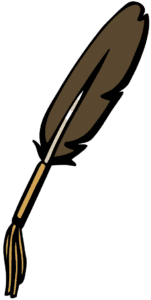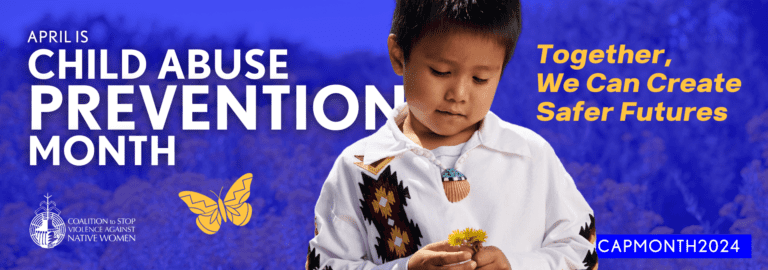By: Angel Charley, CSVANW Executive DirectorOur goal at the Coalition to Stop Violence Against Native Women is to build healthy families and healthy communities. We are an Indigenous, survivor-led organization working toward freeing our communities from violence and the people in our organization hold the lived experience of systemic oppression, historical trauma, and violence. Our grounding in the movement is rooted in the awareness that we have been historically and intentionally underrepresented in the decision-making about our futures, our resources, and our separation and reconnection to our land.
And so, I ask that we begin this conversation with the recognition that the people we seek to uplift into leadership are the people from this same background: people who are living at the deepest intersection of oppression and often without decision-making autonomy. Women, youth, gender expansive people do not live single-issue lives. Power, gender, race, class, privilege, and access deeply impact the lives of the people we seek to center here today.
We are asking ourselves, “how can we advance Indigenous women’s leadership and representation in all levels of government and civil society?” but maybe we should begin with the question, “why aren’t more Indigenous women here now? What has kept them out?”.
The answer should begin with the acknowledgment that these institutions were not built by us, and they were not built for us. In fact, these institutions have long sought to devalue our humanity, strip our dignity, and extract our worth.
It is in these impossible circumstances that we are asking Indigenous women to rise. So, if we are truly intent on transformation, we must disrupt and reconstruct the systems that exist right now. Our goal must be to shift the power that upholds them. Power that has roots in white supremacy, systemic racism, and patriarchy.
For Indigenous women to rise anywhere and everywhere: first we need our land, then we need our language, and finally, we need the resources to sustain our communities so abundantly in love and joy that we might see Indigenous women leaders, youth leaders, gender-expansive leaders…not as an exception against all odds…but, as the standard by which we measure all leadership. All of us here know that Indigenous women bring their entire communities with them when they rise…so then, what does she and her community need to thrive?
For leadership to emerge anywhere we need to hold an unapologetic expectation of access: in all forms. Access to free quality education and childcare, access to a world free of climate chaos, access to livable wages, universal healthcare, and pathways to build generational wealth within our communities.
As I share these thoughts on access, I am reminded that just two years ago at the height of the pandemic in New Mexico, more than half of the covid cases belonged to Indigenous Peoples, a state with only an 11% Indigenous population. This was a clear message that tells us the safety nets meant to cast social protections do not reach into our communities. It tells us that the barriers to health and wellness exist in access to running water, electricity, and broadband. Let alone access to childcare, livable wages, and now in the United States- reproductive care.
 When our basic needs are not met, so too, is our potential for producing leadership.
When our basic needs are not met, so too, is our potential for producing leadership.
And so, as we are pondering the “why” and “how” of social change, we must imagine a future of Indigenous woman leadership that allows us to bring all our roles, our full selves, into the places we dare enter. We are mothers, granddaughters, aunties, providers, caretakers, survivors, even and especially, in our potential leadership.
An equitable and safe space for women means creating an equitable and safe space for family. We eliminate barriers when we strengthen community. To see ourselves reflected in leadership means we must create the circumstances for this to become a reality. We need access to all the things that make leadership possible because the leaders I know right now are tired of being relentless, exhausted from being resilient, and are burning out because they are expected to do it all.
The women and gender-expansive people I know who are in leadership positions got there by being the hardest-working person in the room. By absorbing the excess weight of stress and doing more than their share of the work. They were propelled into leadership without the tools they needed to carve an equitable space for themselves but are steadily working toward diversity, equity and inclusion for those who are coming. The women I know who are getting things done are leaning on one another to achieve the impossible.
Indigenous women need a community of peer leaders who can help uplift their thought leadership; we need a network of accomplished mentors to guide us and soundboard our ideas and struggles. Institutionally we need intentional recruitment, devoted resources to our retainment, and culturally responsible skill development.
To build a future of expansive Indigenous representation, we must work to address the harms caused by systemic racism. Harms that all of us uphold- even in the best of our intentions. Are we recruiting tribal college students to work in our institutions? Are we paying livable wages to the people who work for us right now? Do we require a college degree to get through the door and what value do we place on lived and work experience? Are there clear and defined pathways in our agencies to achieve the role of executive leadership for Indigenous women and gender-expansive people?
If these aren’t practices right now, are we ready to commit to them? The people who are on the cusp of leadership need us to stop protecting the status quo and invest relentlessly in our ability to be seen as Indigenous Women.
The possibility of shifting power lives within our own visibility. We are among matriarchs today, who are the embodiment of our ancestors’ strength that has resisted and is carried here today, visible.
But who is missing among us and how do we get her here?
And as we advocate for this advancement, I ask us to remember that if we want this future for those who are coming, we must also expect it for ourselves, now.
Related Posts

Uplifting Our Social Workers: Honoring Hope, Healing, and Advocacy
As Spring arrives, bringing renewal, growth, and fresh beginnings, we pause to reflect on the…

Our Story Begins with Her
This Women’s History Month, we are honoring the strength, resilience, and wisdom of the matriarchs…

Child Abuse Prevention Month (2024)
Introduction: Child abuse is a significant concern affecting communities worldwide, including Native American populations. Despite…
